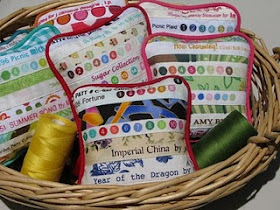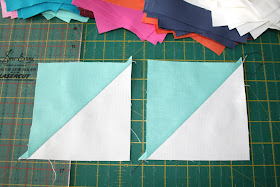Hi, I'm Cindy from Live a Colorful Life, and I'm thrilled to be here, talking about
threads, needles and pins.
I've been a quilter for over fifteen years, after going through many other creative phases. While I tired of the other phases after a while, quilting continues to inspire me, as it constantly changes and evolves. I started out as more of a traditional quilter, but now I would consider myself a modern quilter who likes to put a spin on some of the traditional blocks. While my fabric choices and design ideas have changed into something entirely different from what I started doing as a beginning quilter, a few things have remained the same, and that is the high quality tools I use. This may not be the most exciting topic to read about but it's an important one: thread, needles and pins.
Volumes could be written about thread: types, brands, colors. As a beginning quilter, it is not necessary to have a multitude of thread colors. It IS important to have good quality thread.
These are spools of thread I inherited from my grandmother's sewing kit. I love them, the wooden spools and the colors. However, I would not use a single spool of this thread when piecing a quilt top. It's old, it could be brittle, and I just wouldn't trust it.
These are from Connecting Threads. They carry good quality thread at a very reasonable price.
What I recommend is a good 50-weight cotton in a couple of neutral colors, because they are subtle and blend well. I have a "wardrobe" of neutral colors, ranging from white to black. Start with a couple of neutral colors, and add more colors as your budget allows.The numbers on thread label can be a little confusing. The lower the number, the heavier the thread. In other words, if it takes 50 kilometers of thread to to weigh one kilogram, it will be labeled 50 wt., if it takes 40 kilometers of thread to weight one kilogram, it will be labeled 40 wt. If your brain isn't used to the metric system, never fear. Just remember that a 50 wt. is a good standard thread to use when piecing.
There is often a number after the weight, either a 2 or a 3. This refers to the number of plies. Connecting Threads is a size 50/3 (50 weight, 3 ply), while Superior is 50/2 (50 weight, 2 ply). Both are excellent threads for piecing your quilt top together. Other brands to consider are Aurifil and Gutermann.
While I'm on the topic of thread, it is actually a myth that using polyester thread will tear your fabric. Fabric tearing due to thread has nothing to do with the thread fiber type but rather with the strength of the fibers--both the thread and the fabric. Whichever is the strongest is going to win the battle. However, remember that cotton thread is still a better choice for piecing because it is more heat tolerant and iron-safe. You don't want to be pressing those seams and risk having your thread melt!
If you want to learn more about thread (and I do admit to being a bit of a thread nerd), Superior Threads has a lot of "threadology" information and an excellent chart with guidelines on matching up bobbin thread, needle size, etc.
The bottom line is that a high-quality cotton thread will make the best seam, which just helps everything to match up better.
Now that you have your thread, what kind of needles are you going to use in your machine?
Here again, it's a numbers game. When it comes to needles, the higher the number, the stronger the needle and the heavier thread it can handle. And it's confusing because, again, there is a two-number system. The higher number is a metric measurement of the needle shaft diameter, and the smaller number is the U.S. equivalent of the needle shaft diameter. So a 80/12 would be a finer needle than a 90/14. I started out using a Universal 75/11 but now I am using either a microtex sharp 80/12 or a topstitch 80/12. You don't want to use a ball point needle, which was designed for polyester fabrics, but rather a sharp needle designed for woven fabrics. AND CHANGE THAT NEEDLE EVERY TIME YOU START A NEW PROJECT!
On to pins. My favorite pins are #5004 IBC Fine Silk Pins by Clotilde (or #5003 IBC if you like a pin with a glass head). You want a pin that is strong, long, thin, and very sharp.
As you start learning more quilting techniques and read about how other quilters do things, you will find that some people pin and some don't. I tend to pin a lot and find that the little extra time it takes is definitely worthwhile. First I determine whether I'm going to press the seams to the side or press the seams open. When I first started quilting I always pressed to the side. Now, with very few exceptions, I press my seams open because I feel that it makes the block less bumpy.
Either way, with the seams pressed open or to the side, first line up the seam:
Then place your pin about 1/8" away from the seam.
The back of your block will look like the one on the left if you have pressed your seams to the side, or like the one on the right if you have pressed them open.Either way, the block intersection will look great!
Thanks for having me, Rebecca! Have a great time in Quilt Class, and I hope you all will stop by to see me at Live a Colorful Life.
Oh Thank you Cindy! She is a wealth of knowledge, provides tons of inspiration and has become a close bloggy friend. Thank you for visiting today...
Cindy also has a surprise for us... Have you seen these...
Gorgeous Selvage Pincushions!!
She made one for our Class!!
She custom designed this pressie for me....
and I was so excited when it arrived in the mail yesterday..
and if you don't win... she can custom design one for
YOU!!
Thank you sooo much Cindy xx I just LOVE it!

























































